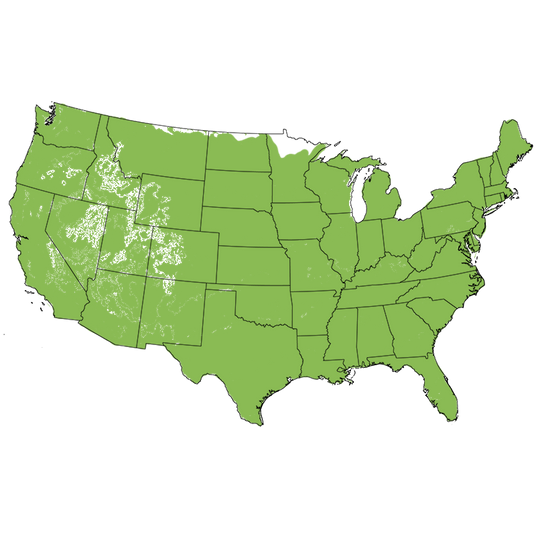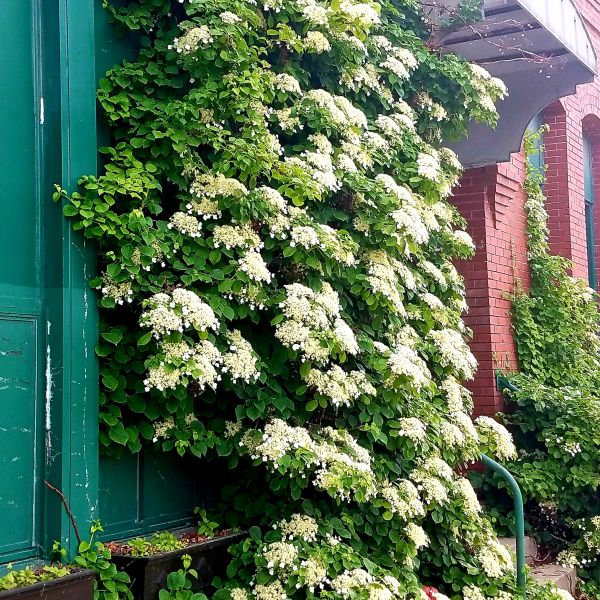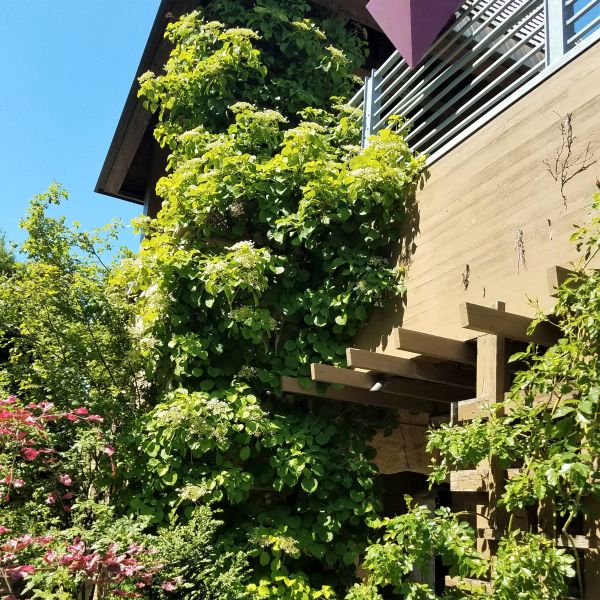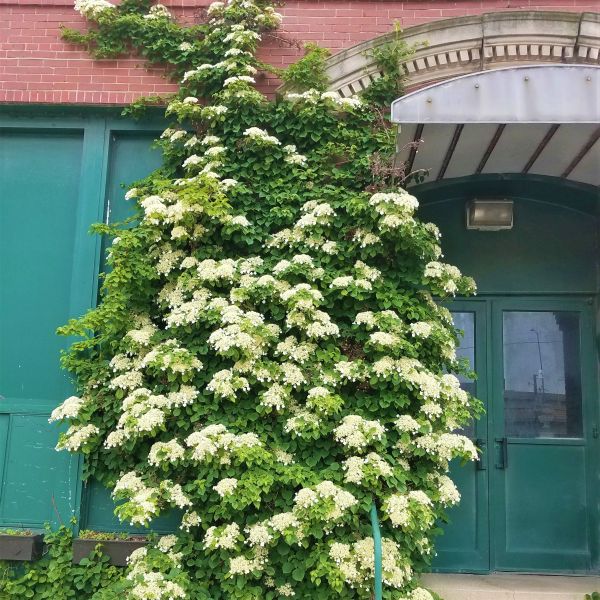Climbing Hydrangea
Hydrangea anomala subsp. petiolaris
Plant Sentry™
Plant Sentry™

Plant Sentry™ Protected
Your order is protected by our compliance system that:
- Prevents restricted plants from shipping to your state
- Ensures plants meet your state's agricultural requirements
- Protects gardens from invasive pests and diseases
Delivery and Shipping
Delivery and Shipping
Delivery and Shipping
Fast, Safe Plant Delivery
Ships in 3-4 business days • Tracking provided • Weather protected
| Under $50 | $9.99 |
| $50 - $99.99 | $14.99 |
| $100 - $149.99 | $16.99 |
| $150 - $198.99 | $24.99 |
| $199+ | FREE |
✓ Zone-specific timing • ✓ Professional packaging • ✓ Health guarantee
Understanding Plant Options
Nature Hills offers plants in two main formats:
- Container Plants: Grown in pots with soil, sized by container volume and plant age
- Bare Root Plants: Dormant plants without soil, sized by height measurements
Container Plant Sizes
Container sizes indicate plant age and growing capacity rather than liquid volume equivalents. Our containers follow industry-standard nursery "trade gallon" specifications, which differ from standard liquid gallon measurements.
Young Plants (6 months to 18 months old)
| Container Size | Actual Volume | Metric Equivalent |
|---|---|---|
| 2" x 2" x 3" | 0.18 - 0.21 dry quarts | 0.20 - 0.23 dry liters |
| 4" Container | 0.31 - 0.87 dry quarts | 0.35 - 0.96 dry liters |
| 4.5" Container | 0.65 dry quarts | 0.72 dry liters |
| 6" Container | 1.4 dry quarts | 1.59 dry liters |
| 1 Quart | 1 dry quart | 1.1 dry liters |
| 5.5" Container | 1.89 dry quarts | 2.08 dry liters |
Established Plants (18 months to 2.5 years old)
| Container Size | Actual Volume | Metric Equivalent |
|---|---|---|
| 2 Quart | 2 dry quarts | 2.2 dry liters |
| #1 Container | 2.26 - 3.73 dry quarts | 2.49 - 4.11 dry liters |
| 5" x 5" x 12" | 3.5 - 4.3 dry quarts | 3.85 - 4.74 dry liters |
Mature Plants (2-4 years old)
| Container Size | Actual Volume | Metric Equivalent |
|---|---|---|
| #2 Container | 1.19 - 1.76 dry gallons | 5.24 - 7.75 dry liters |
| #3 Container | 2.15 - 2.76 dry gallons | 8.14 - 12.16 dry liters |
Large Plants (3-5 years old)
| Container Size | Actual Volume | Metric Equivalent |
|---|---|---|
| #5 Container | 2.92 - 4.62 dry gallons | 12.86 - 20.35 dry liters |
| #6 Container | 5.25 - 6.01 dry gallons | 23.12 - 26.42 dry liters |
| #7 Container | 5.98 - 6.53 dry gallons | 26.34 - 28.76 dry liters |
Bare Root Plants
Bare root plants are sold by height from the root system to the top of the plant. Plants may exceed minimum height requirements.
Common Sizes:
- Trees: 1 foot, 2 feet, 3 feet, 4 feet, 5 feet, 6 feet
- Shrubs & Perennials: 1 foot, 18 inches, 2 feet
Important Notes
Container Volume Specifications
- Trade Gallon Standard: Our containers follow industry-standard "trade gallon" specifications established by the American National Standards Institute (ANSI Z60.1) for nursery stock
- Volume Variations: Actual soil volume may vary due to plant root systems and growing medium settlement
- Age Indicators: Container size primarily indicates plant age and maturity rather than liquid volume equivalents
Growing Conditions
- Plant size can vary based on variety and growing conditions
- Container size helps indicate plant maturity and establishment level
- Larger containers generally mean more established root systems and faster landscape establishment
Seasonal Availability
- Bare root plants are available seasonally when dormant
- Container plants are available throughout the growing season
- Specific varieties may have limited availability in certain sizes
Questions?
For questions about specific plant sizes or availability, please contact our plant experts who can help you choose the right size for your landscape needs.

Plant Sentry™ Protected
Your order is protected by our compliance system that:
- Prevents restricted plants from shipping to your state
- Ensures plants meet your state's agricultural requirements
- Protects gardens from invasive pests and diseases
Plant Profile & Growing Essentials
Cold hardy, Low Maintenance, Flowering, Attracts pollinators, and Non-invasive
Specifications
Specifications
-
Botanical Name
-
Height
-
Width
-
Growing Zones
-
Growth RateModerate
-
Flower Color
-
Leaf Color
-
Fall Color
-
Pollinator FriendlyYes
-
Pollinator Required
-
Bloom PeriodLate Spring, Early Summer, Late Summer
-
Does Not Ship ToAK, HI, ID, MT, OR
Planting & Care Instructions
Planting & Care Instructions

Growing Zones 4-10
Climbing Hydrangea Vine Fragrant Blooms in Shade
- Slow to Establish, Becoming More Vigorous
- Grows in Shade
- Four Seasons of Interest
- Wonderfully Fragrant Flowers, Green Leaves, Stems
- Large Flat Lacecap Flowers From May Persisting Into Summer
- Lush, Dark Green Summer Foliage Turns Yellow for Fall
- Exfoliating Bark Delivers Winter Interest
- Attracts Butterflies
- Long-Lived and Easy Care
- Blooms Last for Long Bloom Period
- Loves Hot/Humid Conditions
- Grows in Full Shade and Part Sun
- Great Cut Flowers Fresh and Dried
If you have more shade than sun, or just have a few shady spots to decorate, try the easy-care Climbing Hydrangea (Hydrangea anomala petiolaris). This perennial vine produces beautiful white lace-cap flowers in late spring and early summer. And it blooms in shade! How nice to finally be able to brighten up those dimly lit areas in your garden.
The Climbing Hydrangea vine is an extremely versatile vine with year-round interest. Glossy green leaves cover eye sores all growing season and then the summer foliage turns brilliant yellow as a nice fall color feature. The exfoliating, reddish-brown bark of mature plants is attractive in winter.
Get ready to see butterflies visiting the wide, flat pretty lace cap flower clusters to gather nectar. All parts of this pretty plant are fragrant, too. And it thrives in shady conditions, can you believe it?
As you might imagine, this desirable plant is in high demand. Nature Hills growers are thrilled to offer this plant, but you should hurry. We will sell out of this selection quickly.
Climbing Hydrangea is native to wooded forests, streams and shaded mountain slopes of Japan, China and South Korea. With a prolific production of large white flowers in late spring and early summer, these unique climbers do take a bit of time to get established.
Please be patient. You may wonder what you are doing wrong when you first plant it as it is a slow starter. Once your Climbing Hydrangea gets established, you will soon notice some nice vigorous shoots and will eventually become more aggressive.
Flowering vines that bloom their heads off in shade are almost impossible to find. These slow-to-start vines are vigorous, easy to care for, and hard to find but our production team has this one figured out!
If you see them in stock on our website, be sure to place your order as soon as you can. You'll be competing with other homeowners who also want to use this special variety to brighten up their shady landscapes. Order now!
How to Use Climbing Hydrangea in the Landscape
Many professional horticulturists agree that there is no better climbing vine than the Climbing Hydrangea. Use this plant for climbing on arbors, fences or the trunks of large trees, and over walls. It also can be grown as a ground cover in shady areas or on steep embankments.
Climbing Hydrangea is one of the best vines for clinging to brick or stone walls. It can be particularly effective when grown against building walls where it can easily attach and cling to the surface using its aerial rootlets are durable holdfasts.
Cold and heat tolerant in USDA hardiness zones 4 through 10. This is also a great selection for espalier in a flat fan shape along the back fence. What a treat for your guests!
If grown on a house, plan to cut around windows and doorways to create a wonderful Fairy Tale cottage or castle. We are sure your imagination is working overtime! Have fun with this wonderful plant.
You'll love to perfume your home with the flowers for fresh-cut arrangements. Allow them to dry for fabulous dried flower displays. Or, just enjoy the reddish-brown dried flower heads on the plant for texture and visual interest. The lace cap blossoms are similar to Hydrangea shrubs and look lovely, romantic and lacy!
Its modified roots will attach to almost any surface. Climbing Hydrangea also can be grown as a flowering groundcover in shady areas or on steep embankments. When left unsupported, the plant mounds to about 3 feet tall and will scramble over the ground. That's much safer and prettier than trying to mow turf on a slope.
On a slope, plant near the top, and point the plants downhill. Plant 6 feet apart on center, measuring from the center of one to the center of the next. Manage their growth by positioning new stems downhill as needed. Keep mass plantings mulched and weeded as they fill in. Add additional rows 20 - 30 feet further downhill.
#ProPlantTips for Care
These lovely deciduous vines grow well in moist, well-drained soils with plenty of organic matter added to planting. It prefers an acid soil of 6 to 6.5 but is adapted to a wide range of soil types as long as the drainage is good.
They are very cold hardy but will need a moderate amount of regular water. Use the Finger Test to see if they need additional water. Push your finger into the soil up to the second knuckle. Is it getting dry? Give it a long drink. Still moist? Skip watering that day.
Climbing Hydrangea will not do well in full sun, give it a partial shade setting for the best results. In colder Zone 5 or in high humidity climates, it can handle more direct morning sun with afternoon shade. If you live in a drier climate or in Zones 8, 9 and 10, you should plant in full shade. Mulch the root zone 3 to 4 inches deep to keep surface roots consistently moist and cool.
Please note that they do take time to get established in your soil. This plant is slow to establish but once it gets well rooted in the ground, the vigor improves dramatically. It is also slow to come into flower, so please remember that patience is a virtue and these gorgeous blooms are worth the wait!
They definitely fit that old garden adage "the first year they sleep, the second year they creep and the third year they leap!" Give it a very sturdy structure to grow on. They'll add so much beauty to shady spots around your yard. Just supply a sturdy trellis for them to climb on and watch them go!
The plant is nearly disease and pest free. The most common problem is chlorosis caused by higher pH soils. Fertilize with Dr. Earth's Acid Lovers Natural and Organic Premium Fertilizer in the fall and after blooming to keep the plant healthy and soil pH acidic.
It blooms on last year's wood, so prune right after its blooms start to fade in the late spring to early summer. Left alone, Climbing Hydrangea develops a bushy, informal habit. Keep it neat and uniform with regular light summer pruning.
Finding Climbing hydrangea for sale can be a challenge. Buy yours from Nature Hills before we sell out
Frequently Asked Questions
How to Grow a Climbing Hydrangea?
Climbing Hydrangea vines do well in moist, well-drained soils with ample acidic organic matter. THey need regular water and protection from full sun.
How quickly do Climbing Hydrangeas grow?
Climbing Hydrangea are slower growing while they are establishing, but then start growing a bit faster once they’re settled. These are long-lived plants and aren’t in any hurry, knowing they’re in it for the long haul, eventually reaching a mature height of 30-40 feet.
Do Climbing Hydrangeas like sun or shade? How much sun do Climbing Hydrangeas need?
Climbing Hydrangea does best in full shade to partial sun/shade, so if you have a full sun location, you are better planting a Climbing Rose, but for that hard to fill the niche of full shade, Climbing Hydrangea are the perfect flowering climbing plant! Provide your Climbing Hydrangea a minimum of all-day dappled shade or 2-4 hours of direct light.
Is Climbing Hydrangeas invasive?
Climbing Hydrangea are not invasive and grow slow enough to be able to keep them contained and from getting into trouble.
What Shipping Options Do You Offer?
NatureHills.com works closely with our growers and nursery professionals to ensure we ship when it is most appropriate for your area. Our goal is to deliver the hardiest plants by avoiding extreme high and low temperatures. Check out our shipping schedule for more information and to learn our wills and won’ts when it comes to shipping plants. Find your Autumn Blooming Cherry for sale here at NatureHills.com!












